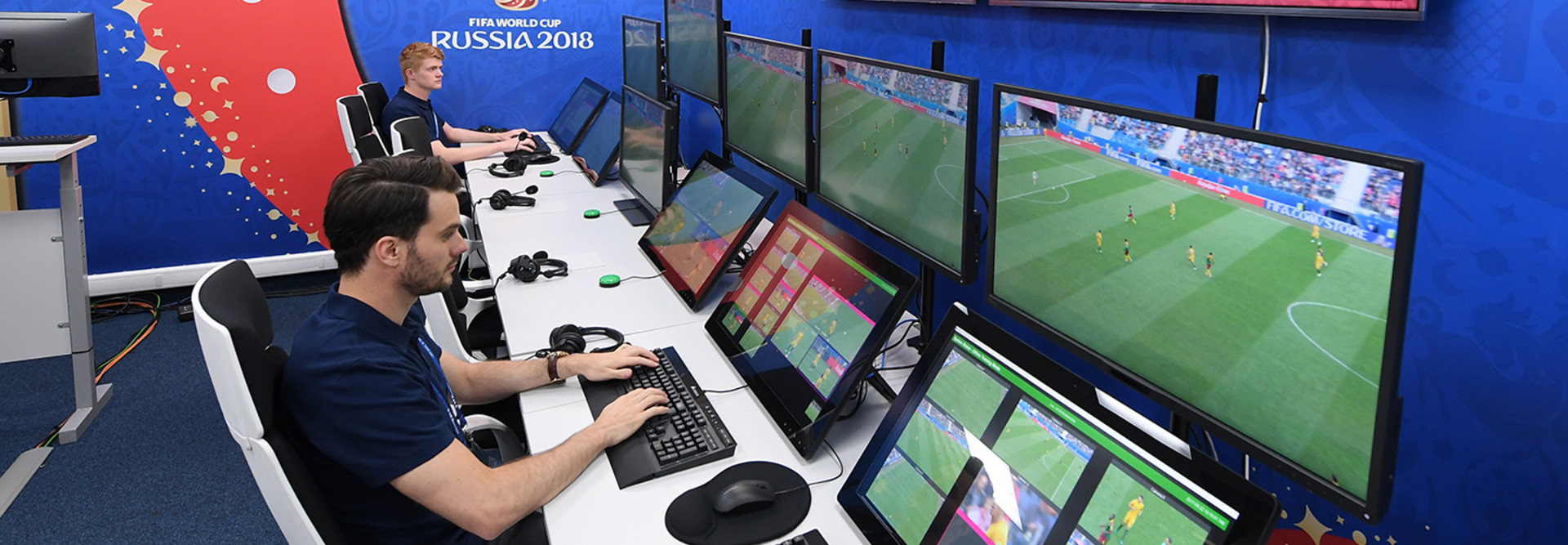The Tech Behind the 2018 FIFA World Cup
There have been several surprising turns at the 2018 FIFA World Cup in Russia, including defending champion Germany’s failure to make it out of the group stage, England’s run to the semifinals, and relatively early exits from soccer powerhouses like Brazil, Portugal and Spain. What’s not surprising is that technology has been a key component of the world’s most-watched sporting event.
For the first time ever at a World Cup, FIFA has instituted a video assistant referee (VAR) system to help support the match referee on key decisions and ensure that calls are made correctly. The introduction of VAR attracted a great deal of controversy before the tournament started in June but has been generally seen as a positive move for the World Cup (though there has been some dissent).
Meanwhile, Fox Sports, the U.S. broadcaster for the World Cup, partnered with IBM to use the tech giant’s Watson artificial intelligence platform to quickly classify, edit and access match highlights in near real time.
The developments suggest that, for a tournament that began in 1930, the fast-paced technology world is weaving its way into the beautiful game in ways unlike ever before.
SIGN UP: Get more news from the BizTech newsletter in your inbox every two weeks!
VAR Helps Refs Make the Right Calls
Although the VAR system is brand new at the World Cup, other sports have used video review for years. How does it work for FIFA?
As the Independent reports, there are 13 officials who can be chosen as the VAR and all of them sit in a video control room in Moscow, with one chosen for each game (along with three assistants).
A lot of tech goes into the VAR system. As Digital Trends reports:
The VAR reviews footage from the numerous cameras stationed around the field; according to FIFA, the video assistant referee team has access to 33 broadcast cameras, eight of which are super slow-motion and four of which are ultra slow-motion cameras. There are ultra high-definition (UHD) cameras as well.
The VAR team watches the entire match, and if they see something amiss they can alert the referee. Likewise, if the on-field ref thinks something is wrong he can contact the VAR operation room. Ultimately though, the VAR team only serves an advisory role and the final decision rests with the match referee.
What does VAR help review? There are four main categories, according to FIFA:
- Goals: The system can be used to check if the ball crossed the goal line, but also if an infringement before the ball went in would have stopped a goal from being awarded.
- Penalties: VAR can determine if a penalty should have been awarded when it wasn’t, and also the reverse: if the referee mistakenly awarded a penalty for a foul inside the penalty box.
- Red cards: VAR can help determine if a red card should be awarded to a player after a foul (players who receive red cards are forced to leave the field and the team must continue one player short).
- Mistaken identity: This part of the VAR system helps refs determine if the wrong player has been disciplined for a foul.
As the Telegraph notes, VAR has had an impact on this year’s tournament: “The system has already been used in the World Cup group stages and Round of 16 to correct and clarify decisions, including Diego Costa’s first goal against Portugal, France’s penalty against Australia as well as Sweden’s penalty against South Korea.”
Fox Teams with IBM’s AI for World Cup Highlights
In June, IBM announced a partnership with Fox Sports for the broadcaster to use IBM Watson Media’s AI video technology and IBM iX’s user experience technology. The goal is to allow Fox to streamline production workflows so that it can quickly identify, edit and deliver match highlights essentially as they are happening. That enables Fox to create more engaging highlight reels for World Cup fans.
The 2014 World Cup attracted 3.2 billion viewers on TV and an estimated 280 million online viewers. Overall, 98,087 hours of video footage was broadcasted. To sift through a similar amount of footage for the 2018 World Cup requires a significant amount of processing power.
“We are delighted to be working with IBM, a leader in the technology space, to help enhance fan experiences and engagement,” Sarah Tourville, senior vice president of sports brand activations at Fox Sports, says in the statement. “Our collaboration affords us an opportunity to utilize their technology across multiple properties, helping to drive engagement for our tentpole events in non-traditional ways.”
Fox and IBM are partnering to create what they call The Highlight Machine, an interactive experience that allows fans to browse FIFA’s archive and create custom highlights from both the historic and 2018 tournament footage.
According to Engadget, Fox says there are 300 archived matches that Watson is capable of analyzing, which viewers filter by World Cup year, team, player, game, play type or any combination of these.
Fans are also able to view and filter highlights by team, player, time frame and type of gameplay, such as penalty kicks and goals. “To extend the post-match conversation on social media, viewers can save, favorite and share highlight reels as well as catch up on games by speedwatching critical, automatically generated clips,” Fox and IBM say in the statement.









